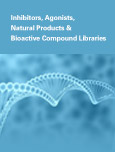| Cat. No. |
Product Name |
Information |
| PC-42994 |
UNC2025 hydrochloride
Mer/FLT3 inhibitor
|
UNC2025 is a potent, orally bioavailable Mer/FLT3 dual inhibitor with IC50 of 0.74/0.8 nM, 700-fold less active against Met compared to Mer. |
| PC-42993 |
UNC2025
Mer/FLT3 inhibitor
|
UNC2025 is a potent, orally bioavailable Mer/FLT3 dual inhibitor with IC50 of 0.74/0.8 nM, 700-fold less active against Met compared to Mer. |
| PC-62809 |
Axl-IN-21
|
Axl-IN-21 is a selective and potent inhibitor of wild-type Axl with IC50 of 2.2 nM. |
| PC-61780 |
TAM-IN-1
Mer/Axl inhibitor
|
TAM-IN-1 is a highly potent, macrocyclic inhibitor of Mer and Axl with Ki of <50 pM and 130 pM, respectively. |
| PC-61679 |
UNC-1062
Mer inhibitor
|
UNC-1062 is a potent and selective Mer kinase inhibitor with IC50 of 1.1 nM, Ki of 0.33 nM. |
| PC-61325 |
N-butylidenephthalide
|
N-butylidenephthalide (NSC 325307) is a natural compound derived from Angelica sinensis that inhibits malignant brain tumor growth in vitro and in vivo. |
| PC-60247 |
RU-302
TAM receptor inhibitor
|
RU-302 is a small molecule pan-TAM inhibitor that targets the TAM Ig1-Gas6 interface, blocks Gas6-dependent TAM activation. |
| PC-60246 |
RU-301
TAM receptor inhibitor
|
RU-301 (RU301) is a small molecule pan-TAM (Tyro3-Axl-Mer)) inhibitor that targets the TAM Ig1-Gas6 interface, blocks Gas6-dependent TAM activation. |
| PC-42292 |
CEP-40783
AXL/c-Met inhibitor
|
CEP-40783 (CEP40783, RXDX-106) is a potent and selective AXL/c-Met inhibitor with IC50 of 7 nM/12 nM. |
| PC-24679 |
SLC-391
Axl inhibitor
|
SLC-391 (SLC-0211) is a potent, selective small molecule inhibitor for AXL with IC50 of 9.6 nM, 4-fold selective over TYRO3 (IC=42.3 nM) and MER (IC50=44 nM). |
| PC-24514 |
UNC8212
TAM kinases inhibitor
|
UNC8212 is a potent, selective inhibitor of TAM-family (TYRO3, AXL, and MERTK) tyrosine kinases with IC50 of 1.5 nM, 1.3 nM, and 6.7 nM for MERTK, AXL and TYRO3 respectively. |
| PC-24400 |
UNC9435
TYRO3/MERTK inhibitor
|
UNC9435 is a potent, dual TYRO3/MERTK inhibitor with IC50 of 3.7/1.1 nM respectively, has 46-fold and 120-fold selectivity of MERTK over AXL and FLT3, respectively. |













